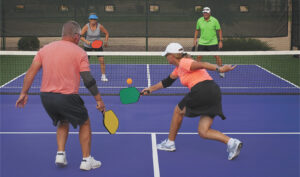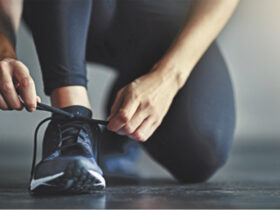By Joe Altepeter, DPM
 As temperatures are cooling off in Southwest Florida, the competition on the pickleball court is heating up. And as the intensity of the match grows, so does the risk of injury. Despite the pickleball court being considerably smaller than a tennis court, the sport can require a significant amount of quick lateral movements and plyometrics, putting your feet and ankles in vulnerable positions. While the majority of afflictions occur from the waist up, more than a quarter of all pickleball-induced ailments involve the lower extremities.
As temperatures are cooling off in Southwest Florida, the competition on the pickleball court is heating up. And as the intensity of the match grows, so does the risk of injury. Despite the pickleball court being considerably smaller than a tennis court, the sport can require a significant amount of quick lateral movements and plyometrics, putting your feet and ankles in vulnerable positions. While the majority of afflictions occur from the waist up, more than a quarter of all pickleball-induced ailments involve the lower extremities.
Arguably the most commonly injured structure would be the Achilles tendon and its associated musculature, this is particularly true for male participants. The Achilles tendon is the strongest and largest tendon in the body and attaches two to three important muscles in the calf to the back of the heel bone, the calcaneus. Sudden or progressively excessive stretch placed on the muscle group can be seen with lunges or falls (among other mechanisms), and can cause damage at a few different levels to varying degrees. The muscle, the tendon, their interface with each other (aponeurosis) and their connection with bone can all be affected. Symptoms can vary from sudden onset of a cramping or bruising sensations, swelling, and difficulty bearing weight. To a more serious degree the structures may tear more significantly or even completely, resulting in sudden onset of considerable sharp pain in the back of the calf or heel, that can be associated with an audible pop or snap. Some have described this sensation as comparable to being kicked or shot. With a complete rupture of the tendon we would see significant difficulty walking and inability to point the foot downwards.
Another relatively common lower extremity injury that can occur with a misstep or a fall would be an ankle sprain. Just as the Achilles can involve damage at different levels, the lateral ankle can involve damage to different structures. The weakest ligament in the ankle connects the outside of the ankle to the top of the foot. When there is sudden inversion stress placed on the foot, or inward twisting of the ankle, this structure can be damaged, resulting in a low ankle sprain.
Depending on the degree of damage, there could be fairly immediate swelling over the front ankle joint, pinpoint tenderness over the ankle joint, and difficulty difficulty putting weight on the foot. With the more advanced injuries there can even be damage to the joint surfaces within the ankle.
With a similar mechanism of injury, particularly if there is low density or weakness, the bones could take the brunt of the force, resulting in fracture of the fifth metatarsal on the outside of the foot and/or of the fibula on the outside of the ankle. Either of these injuries would make it exceedingly uncomfortable to bear weight on the foot.
A few preventative measures can be key for decreasing the likelihood of incurring an injury on the court. First, it is important to be prepared from a gear standpoint. Proper supportive shoes can help stabilize the feet and reduce certain injuries. Second, preparation from a physical standpoint is important. Ensuring appropriate dynamic stretching and warm up exercises are done before play, and saving the static stretches for after the match, are valuable tips for performance and recovery. Diversifying and gradually increasing demands of exercise regimens leading up to competitive seasons can help negate overuse injuries. And finally, being realistic with the level of competition can prevent overexertion and accidents on the court.
These or any other pickleball related injuries experienced can have lasting effects. Soft tissue injuries have a tendency to linger and/or recur if they are not treated appropriately, and bony injuries increase the potential for arthritic changes within the afflicted joints. Seeking medical treatment as soon as possible is imperative for a more predictable and speedy recovery.
Disclaimer: This content is not intended to be a substitute for professional medical advice, diagnosis, or treatment. Always seek the advice of your physician or other qualified health care provider with any questions you may have regarding a medical condition.
Joe Altepeter, DPM, AACFAS, is a Podiatrist at Family Foot & Leg Centers in Fort Myers FL. He is a Fellow of the American College of Foot & Ankle Surgeons. Call 239-430-3668 or visit www.NaplesPodiatrist.com to make an appointment. Visit FootHealthFacts.org to learn more about foot and ankle conditions.
1645 Colonial Blvd.
Fort Myers, FL 33907
(239) 430 – 3668 (FOOT)
www.NaplesPodiatrist.com









